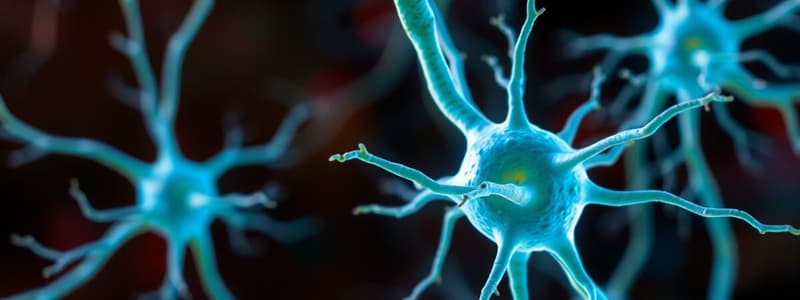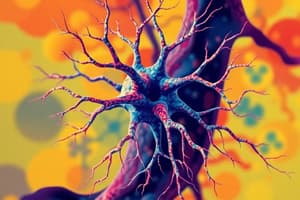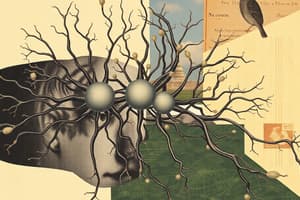Podcast
Questions and Answers
Which of the following best describes the organization of a neuron?
Which of the following best describes the organization of a neuron?
- A functional unit containing dendrites, a cell body, and an axon. (correct)
- A collection of sensory receptors that directly stimulate muscle contractions.
- A linear arrangement of nerves connected by ganglia.
- A nerve net connected to a centralized brain.
What role do interneurons play in the nervous system?
What role do interneurons play in the nervous system?
- They process information received from sensory neurons and transmit it to different body regions. (correct)
- They produce motor responses based on external stimuli.
- They transmit signals directly from sensory neurons to muscles.
- They regulate the internal physiological state of an animal.
What is the functional significance of the axon hillock in a neuron?
What is the functional significance of the axon hillock in a neuron?
- It is the site where synaptic stimuli are summed to trigger an action potential. (correct)
- It is the location where neurotransmitters are synthesized.
- It is responsible for the reuptake of neurotransmitters from the synaptic cleft.
- It provides structural support to the neuron.
What distinguishes neurotransmitters from action potentials in neuronal signaling?
What distinguishes neurotransmitters from action potentials in neuronal signaling?
What is the primary mechanism for establishing the resting membrane potential in a neuron?
What is the primary mechanism for establishing the resting membrane potential in a neuron?
During the depolarization phase of an action potential, what key event takes place?
During the depolarization phase of an action potential, what key event takes place?
How do neurons encode information about the intensity of a stimulus?
How do neurons encode information about the intensity of a stimulus?
What is the role of glial cells in the nervous system?
What is the role of glial cells in the nervous system?
Why can't action potentials propagate backward along an axon?
Why can't action potentials propagate backward along an axon?
Which of the following describes saltatory propagation?
Which of the following describes saltatory propagation?
What is the role of voltage-gated calcium channels in synaptic transmission?
What is the role of voltage-gated calcium channels in synaptic transmission?
How do neurotransmitters affect the postsynaptic membrane potential?
How do neurotransmitters affect the postsynaptic membrane potential?
Which of the following describes the difference between temporal and spatial summation?
Which of the following describes the difference between temporal and spatial summation?
What primary function does the central nervous system (CNS) serve?
What primary function does the central nervous system (CNS) serve?
What role does the thalamus play in processing sensory information?
What role does the thalamus play in processing sensory information?
What is the primary function of the hypothalamus?
What is the primary function of the hypothalamus?
What is a key function of the cerebellum?
What is a key function of the cerebellum?
Which lobe of the cerebral cortex is primarily responsible for processing auditory information?
Which lobe of the cerebral cortex is primarily responsible for processing auditory information?
What are the major components of the peripheral nervous system (PNS)?
What are the major components of the peripheral nervous system (PNS)?
How do the somatic and autonomic nervous systems differ in function?
How do the somatic and autonomic nervous systems differ in function?
What are the two main divisions of the autonomic nervous system, and what general functions do they serve?
What are the two main divisions of the autonomic nervous system, and what general functions do they serve?
Which property do animals use to sense their environment?
Which property do animals use to sense their environment?
What is the sequence of sensory processing?
What is the sequence of sensory processing?
How do animals sense chemical stimuli?
How do animals sense chemical stimuli?
A cell's response to chemical binding resulting in it opening an ion channel is called?
A cell's response to chemical binding resulting in it opening an ion channel is called?
How is light detected in photoreceptors?
How is light detected in photoreceptors?
What can rods in animal vision detect?
What can rods in animal vision detect?
Which photoreceptor enables color vision, and how does it achieve this?
Which photoreceptor enables color vision, and how does it achieve this?
A human's single-lens eye is advantageous because?
A human's single-lens eye is advantageous because?
What is a flatworm's eyecups?
What is a flatworm's eyecups?
How do organisms with eyecups respond to light?
How do organisms with eyecups respond to light?
What are compound eyes composed of?
What are compound eyes composed of?
What are receptors of olfaction and tastes buds?
What are receptors of olfaction and tastes buds?
What is responsible for the ''fight-or-flight'' response?
What is responsible for the ''fight-or-flight'' response?
Flashcards
What is a nervous system?
What is a nervous system?
All multicellular animals, except sponges, possess this system; it responds to stimuli.
What are neurons?
What are neurons?
Cells in the nervous system that transmit electrical signals.
What is a nerve net?
What is a nerve net?
A network or mesh of interconnected nerve cells.
What is ganglia?
What is ganglia?
Signup and view all the flashcards
What are dendrites?
What are dendrites?
Signup and view all the flashcards
What is the cell body?
What is the cell body?
Signup and view all the flashcards
What is the axon?
What is the axon?
Signup and view all the flashcards
What are sensory, inter, and motor?
What are sensory, inter, and motor?
Signup and view all the flashcards
What are sensory neurons?
What are sensory neurons?
Signup and view all the flashcards
What are interneurons?
What are interneurons?
Signup and view all the flashcards
What are motor neurons?
What are motor neurons?
Signup and view all the flashcards
What is an action potential?
What is an action potential?
Signup and view all the flashcards
What are neurotransmitters?
What are neurotransmitters?
Signup and view all the flashcards
What is membrane potential?
What is membrane potential?
Signup and view all the flashcards
What is resting membrane potential?
What is resting membrane potential?
Signup and view all the flashcards
What is depolarization?
What is depolarization?
Signup and view all the flashcards
What is rate and timing of APs?
What is rate and timing of APs?
Signup and view all the flashcards
What are glial cells?
What are glial cells?
Signup and view all the flashcards
What is saltatory propagation?
What is saltatory propagation?
Signup and view all the flashcards
What is a synapse?
What is a synapse?
Signup and view all the flashcards
What are EPSPs?
What are EPSPs?
Signup and view all the flashcards
What are IPSPs?
What are IPSPs?
Signup and view all the flashcards
What is temporal/spatial summation?
What is temporal/spatial summation?
Signup and view all the flashcards
What is the central nervous system?
What is the central nervous system?
Signup and view all the flashcards
What is the peripheral nervous system?
What is the peripheral nervous system?
Signup and view all the flashcards
What is the forebrain?
What is the forebrain?
Signup and view all the flashcards
What is the hindbrain?
What is the hindbrain?
Signup and view all the flashcards
What is the frontal lobe function?
What is the frontal lobe function?
Signup and view all the flashcards
What is the function of the parietal lobe?
What is the function of the parietal lobe?
Signup and view all the flashcards
What is temporal lobe function?
What is temporal lobe function?
Signup and view all the flashcards
What is the Occipital lobe?
What is the Occipital lobe?
Signup and view all the flashcards
What is gray matter?
What is gray matter?
Signup and view all the flashcards
What is white matter?
What is white matter?
Signup and view all the flashcards
What is the main function of the thalamus?
What is the main function of the thalamus?
Signup and view all the flashcards
What is the autonomic nervous system?
What is the autonomic nervous system?
Signup and view all the flashcards
What is somatic component?
What is somatic component?
Signup and view all the flashcards
What is the sympathetic system?
What is the sympathetic system?
Signup and view all the flashcards
What are sensory receptors?
What are sensory receptors?
Signup and view all the flashcards
What is sensory transduction?
What is sensory transduction?
Signup and view all the flashcards
What is chemoreceptors?
What is chemoreceptors?
Signup and view all the flashcards
What is are Mechanoceptors?
What is are Mechanoceptors?
Signup and view all the flashcards
Study Notes
Animal Nervous Systems
- Sponges are the only multicellular animals that do not possess a nervous system.
Nerve Cells and a Nervous System
- Neurons/nerve cells are the basic functional unit of the nervous system.
- Neurons connect to form nerve nets, nerves, ganglia, and brains.
- Arrangement depends on the organism.
Types of Neurons
- All neurons share 3 main components:
- Dendrites
- Cell body
- Axon
- Sensory neurons send and receive information about an animal’s environment / internal physiological state.
- Respond to physical things like temperature, light, and touch.
- Respond to chemical signals such as odor and taste.
- Interneurons process information received by sensory neurons and transmit it to different body regions.
- Motor neurons produce a motor response based on information received from sensory and interneurons.
Neuron Structure
- Stimuli are received by the dendrites and cell body.
- Synaptic stimuli is summed at the axon hillock, where an action potential is triggered if the sum of the arriving signals is high enough.
- Action potentials are conducted to the axon terminal, where they cause the release of neurotransmitters stored in vesicles.
- Neurotransmitters bind to receptors on the postsynaptic cell membrane, creating a new signal in the postsynaptic neuron.
- In all neurons: Dendrites, cell body, and axon are present.
Electrical Signals
- Action potentials are a brief electrical signal transmitted from the cell body along one or more axon branches.
- Neurotransmitters are chemical signals and action potentials are electrical signals.
- Neurons have electrically excitable plasma membranes that can transmit information.
- When a cell does not receive a signal, there are more negative ions on the inside of the cell; there is an overall negative charge relative to the outside.
- A charge difference is known as the membrane potential.
- The negative voltage across the membrane at rest is referred to as the cell’s resting membrane potential.
- Created by Na+/K+ pump AND the leak of K+ out of the cell at rest via sodium and potassium movement.
- When a nerve cell is excited, its membrane becomes less negative/less polarized - called depolarization.
- After depolarization:
- If the change reaches a threshold potential, an action potential is produced.
Information Coding
- Neurons code information by changing the rate and timing of action potentials.
- "Strength" is not a factor, as action potentials are "all-or-none"
- A higher firing frequency codes for a more intense stimulus.
- E.g. brighter light, louder noise, stronger signal transmitted by the nerve cell to other cells it contacts.
Glial Cells and Propagation
- Glial cells do not transmit electrical signals - they provide support, insulation and nutrition to the neurons.
- Action potentials propagate from cell body toward the axon terminals in one direction.
- They cannot propagate backward.
- Saltatory propagation increases the speed of conduction.
Synapses: Communication Between Neurons
- Synaptic transmission starts with action potential conduction to the axon terminal.
- Depolarization of the axon terminal opens voltage gated Ca2+ channels
- Vesicles respond by fusing with the presynaptic membrane, releasing neurotransmitters into the synaptic cleft.
- Neurotransmitters bind with receptors on the postsynaptic cell (ligand gated ion channels), opening the channels to allow in ions and causing a change in membrane potential.
- Neurotransmitters are actively re-absorbed into the presynaptic terminal and stored in vesicles until the next action potential arrives.
- This is where the electrical signal becomes a chemical signal.
- Excitatory synapses transmit relevant information between nerve cells
- Excitatory Post-Synaptic Potential = EPSP
- Inhibitory synapses filter out unimportant information
- Inhibitory Post-Synaptic Potential = IPSP
- EPSPs and IPSPs can be summed over time (temporal summation) and space (spatial summation).
- Summation of EPSPs and IPSPs are the fundamental forms of information processing by the nervous system
- They provide mechanisms for determining whether a particular sensory stimulus is responded to or ignored.
Nervous System Organization
- The nervous system is separated into the central nervous system, and the peripheral nervous system.
- Central Nervous System
- Brain
- Spinal Cord
- Organizes/coordinates complex responses to sensory information.
- Brain:
- The cerebral cortex governs most advanced cognitive functions, and has mutliple lobes with different functions:
- Frontal: decision-making and planning
- Parietal: body awareness
- Temporal: processing sound
- Occipital: processing vision
- The cerebral cortex governs most advanced cognitive functions, and has mutliple lobes with different functions:
- Gray matter in the cerebral cortex
- Appears gray because of the densely packed cell bodies of neurons.
- Found in the superficial regions of the cortex.
- Highly folded to increase surface area which allows for an increased number of neurons.
- White matter in the cerebral cortex
- Appears white due to the myelin produced by glial cells.
- Contains axons (covered in myelin).
- Allows for communications between the grey matter and other regions of the brain.
- The thalamus relays sensory information from below to the cortex.
- The hypothalamus interacts with the autonomic portion of the PNS and the endocrine system.
- The cerebellum coordinates actions for complex motor tasks (catching a ball, writing), integrating sensory and motor information.
- Peripheral Nervous System:
- Includes cranial nerves and spinal nerves
- Contains an autonomic and somatic division
- The somatic nervous system includes sensory neurons that respond to external stimuli and motor neurons that synapse with voluntary muscles.
- The autonomic nervous system includes both sensory and motor nerves, which act without our conscious awareness (involuntary).
- The autonomic nervous system controls internal functions of the body like heart rate, blood flow, digestion, excretion, and temperature.
- Contains sympathetic (fight-or-flight) and parasympathetic (rest and digest) divisions
Sensory Receptors and Transduction
- Animals sense their environment through physical properties and sensory receptor cells that detect features in the environment
- Housed in sensory organs: eyes, ears, nose, mouth.
- Physical stimuli converted to an action potential = Sensory Transduction.
- Chemoreceptors
- Mechanoreceptors
- Photoreceptors
- Detect chemical stimuli in the environment
Senses
- Activation of a receptor leads to signaling which opens an ion channel and causes depolarization of the cell.
- Important for taste and smell.
- Mechanoreceptors
- Detect physical forces
- Mechanical forces directly open ion channels and cause depolarization of cell
- Important for hearing and balance.
- Photoreceptors
- Detect light
- Respond to light energy by closing Na+ channels, causing cell membrane to become hyperpolarized rather than depolarized
- Important for vision.
- Olfactory receptors respond to chemical odors (chemoreceptors) in the nasal passages.
- Taste cells are chemosensory receptors located in taste buds, and they send information to the brain through sensory neurons.
- The perceived flavor of food depends on both the sense of taste and the sense of smell.
- Sensory receptors of olfaction / taste buds = chemoreceptors.
- The light-sensitive protein Opsin is what turns light into electrical signals.
- Rods detect light and change it into different shades of white, grey, and black; they are very numerous/sensitive & good in low light
- Cones detect blue, green, or red light; mixing the colors enables a full range of vision.
- Single-lens eyes are for vertebrates
- Give advantages as they can focus light rays on a particular region of photoreceptors, and improve image quality and sensitivity.
- Flatworms have eyecups to detect direction and intensity of light used to determine the direction of movement
- Move directly from light to avoid predators.
- Compound eyes:
- Consist of a large number of individual light-focusing lenses.
- The more lenses, the higher the resolution.
Studying That Suits You
Use AI to generate personalized quizzes and flashcards to suit your learning preferences.




